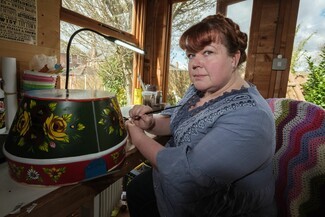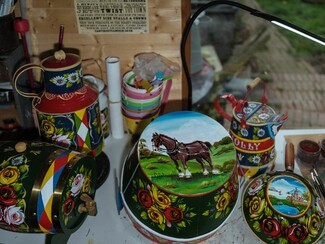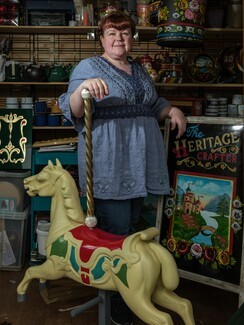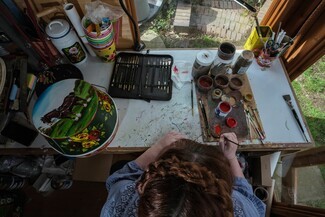Profile on canal artist Kerri Willams

Midlands-based canal artist Kerri Williams speaks to Imogen Bright Moon about her crafts practice and why she loves traditional waterway arts. Photographs by Bela Varadi.
“I was taught the craft by canal artist Julie Tonkin,” says Kerri Williams, “and it was a strange start to learning canal art for me; I originally booked the course for my dad as a gift, as he has boaters and coal-women on his side of the family. Sadly, he passed two weeks before the course started. I had to decide if I should do it in his place, so I decided to go, because it’s what he would have wanted."

"At the end of the course, Julie tapped me on the shoulder and she said ‘come back tomorrow’. I went back every day for about two years, as an informal apprentice, she was wonderful, she taught me everything; and not just about ‘this is how you paint a rose’; but historically why you paint the rose, the style of rose, this is how you paint it on a working boat… all the things I’d experienced in my childhood hopping on and off boats but not really taking notice, now I was this little bit older, and with my dad on my shoulder, it was time to learn more. It was exactly the right time, the right moment."

"I like painting the boats themselves, especially if they are working boats, and I like painting items that belong to boats as well, items like water cans. I think my favourite though is painting nose-bowls which are traditionally for the horses, so as the horses were pulling the barges along the canal, they’d have a metal bucket attached to their harness, and they’d have a little chomp as they walked along, and I really love painting those as I’ve got horses myself, so it’s a link to that, and it just makes me think of all those horses making those journeys day in day out."

"I’ve got some of the tools my dad used to use; if I’m painting something special I’ll use his brushes, then put them away; it’s a link to him, and he’s the reason I do canal art, and I’ve picked up the tradition of canal art through my dad’s love and appreciation of the tradition. To keep our crafts going, we’re going to have to think about how we deliver history to people, how we capture their imagination; getting them interested young, appreciating living history, and thinking about how we bring that living history forward, and that’s not easy, but it’s vital.”
By Imogen Bright Moon
(All photographs © Bela Varadi/TT)